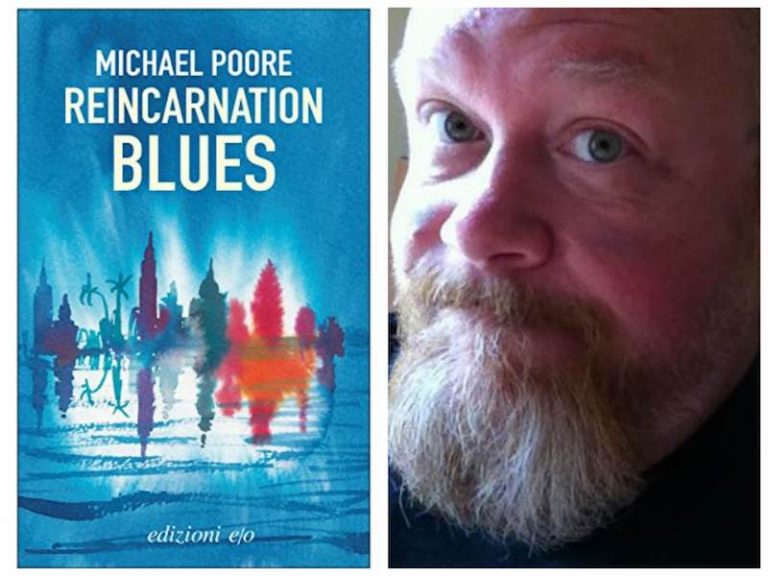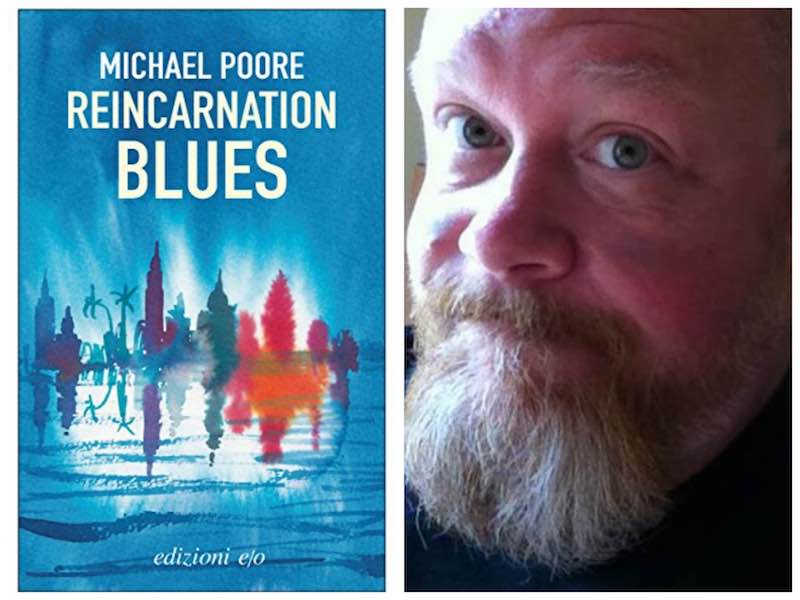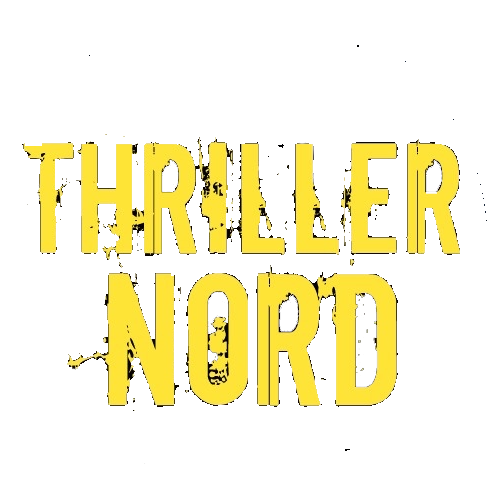A tu per tu con l’autore
A tu per tu incontra Michael Poore, un interessante e simpatico scrittore americano. Per thrillernord abbiamo recensito il suo secondo romanzo Reincarnation blues.
Da cosa è nata l’idea di sviluppare la storia sulla reincarnazione? Cosa l’ ha ispirata?
Durante un lungo viaggio attraverso il deserto dell’Arizona con mia moglie e mia figlia, ho cominciato a pensare a come mio zio, anni prima, se ne fosse andato via dal West, con la sua band di rock-n-roll. In quei giorni, assunse droghe e bevve litri e litri di whiskey. Poi diventò un serio padre di famiglia, ma i danni che il suo corpo aveva subito lo portarono alla morte all’età di cinquant’anni. Io ho avuto un altro paio di parenti, che sono morti in mezza età, a causa di ciò che avevano fatto in gioventù.
Per questo ho pensato di scrivere una storia su di una coppia sposata che rendendosi conto di essere quasi in fin di vita a causa degli stravizi fatti, decide di trovare un modo divertente e “teatrale” di morire. Mentre stavo pensando a questo, ci siamo fermati ad una stazione di benzina, ed il benzinaio, così, per divertimento, teneva un’auto abbandonata parcheggiata lì accanto, con uno scheletro di plastica seduto al volante. Questa immagine mi ha dato l’idea di Morte che segue la coppia in fin di vita, e magari la incontra e ne fa la conoscenza. Ho poi portato avanti questa idea. Come sarà quando moriranno? Cosa gli succederebbe nell’aldilà? Cosa accadrebbe se rinascessero? In questo modo è nata l’idea del libro.
How was born the idea to develop the reincarnation’s theme? What inspired you?
I was on a long road trip with my wife and daughter, driving across the Arizona desert. I had started thinking about how my uncle had gone out west, years ago, with his rock-n-roll band. Back in those days, they took a lot of drugs and drank a lot of whiskey. He eventually became a family man, but the damage to his body was done, and he died at age fifty. I had two other relatives, also, die in their middle years because of things they had done when they were young. So I was thinking of writing a story about a married couple who realized their bodies were damaged and dying, who decided to find a dramatic and fun way to die. As I was thinking about this, we stopped at a gas station, and just for fun the owner had an old abandoned car sitting outside with a plastic skeleton at the wheel. This gave me the idea to have Death follow the dying couple around, and perhaps even meet them and get to know them. I kept pushing the idea further. What would it be like when they died? What if they experienced an afterlife? What if they were born again? That’s how the idea for the book got started.

Come perno del romanzo abbiamo numerosi riferimenti filosofici e spirituali, è un argomento importante nella sua vita di ogni giorno?
Come Platone, sono convinto che la maggior parte di ciò che vediamo e sperimentiamo sia solo la pallida ombra di una realtà più profonda e completa. Per cui, si, secondo me, la parte più appagante dell’essere vivi è la ricerca delle energie profonde che si celano dietro le forme che abitiamo. E questa ricerca mi ha portato in molti luoghi. Le religioni del mondo, sia quelle oscure che quelle di luce, sono finestre verso una visione del mondo più completa. Così come una visita al supermercato, un libro, uno programma tv spazzatura, un nuovo o vecchio amico. Cerco lo scorrere del tempo e la trasformazione in tutto quello che faccio, ovunque vado. Può essere molto utile caratterizzare queste cose come buone o cattive, in quanto ciò , mi insegna molto su di me e sulla mia mente.
The core of your book are the numerous philosophical and spiritual references, is that an important matter in your everyday life?
Like Plato, I’m convinced that most of what we see and experience is a shadow-play, expressions of deeper, more complete realities. So, yes, the most fulfilling part of being alive, for me, is the search for those larger energies behind the forms we inhabit. And that search has taken me many places. The religions of the world – both light and dark – are rich windows into a more complete world. So is a visit to the supermarket, a book, or a trashy television show, or a new or old friend. Everything I do, everywhere I go, I find I’m looking into the eye of time and transformation. It can be very useful to characterize these things as gods and devils, which, in turn, teaches me about my own mind, my own self.
Come mai ha scelto la figura della morte come figura della quale innamorarsi?
Come molti artisti tendo a dare un’identità sessuale alle cose. Quando il mio personaggio incontra Morte, era probabilmente inevitabile che considerassi quanto sensuale debba essere morire, essere „fidanzato“ con la morte. Per cui mi è risultato naturale immaginare come avrebbe potuto essere Morte come amante. E non solo per una notte, ma per una relazione duratura. Domande tipo „Come sta Morte“ conducono a momenti di comicità come „Che tipo di birra preferisci Morte?“ e „Come è Morte quando incappa in una giornata storta?“
Infatti ciò è materia di Milo, il personaggio principale, che ha interagito – incontrato Morte – circa 10.000 volte. Devono aver fatto una profonda conoscenza e molte curiosità saranno emerse. Essendo personaggi „magici“ hanno la possibilità di avere una storia d’amore. Sicuramente, la vostra amante vi da baci deliziosi, ma cosa accadrebbe se mordesse anche? Cosa accadrebbe se i suoi occhi avessero letteralmente il fuoco dentro? Se ci fosse un pericolo che lei può superare e voi no? Di fatto, naturalmente, questa storia romantica è proibita. Uomini e donne non possono amare le divinità senza alcun pericolo, tanto quanto sarebbe impossibile condurre una relazione personale con l’Estate o con il mare.
Why did you choose Death as the figure to fall in love with?
Like many artists, I tend to sexualize things. When my main character encountered Death, it was probably inevitable that I considered how sensual it must be to die, to be engaged in dying. So it seemed natural to wonder what Death would be like as a lover. And not just for one night, but as a serious companion. Questions like „What does Death feel like“ led to comical questions like „What kind of beer does Death prefer?“ and „What is Death like when she is having a bad day?“ Also, there was the matter of Milo, the main character, having experienced death – met Death – nearly 10,000 times. They would have been well-acquainted, and curiosities might have emerged. And magical characters bring such possibility to a love story. Sure, your lover gives delicious kisses, but what if she also bites? What if her eyes literally have fire in them? What if there were a adanger she could get carried away and consume you? Because, of course, this romance is forbidden. Men and women cannot love gods without danger, any more than we can carry on a personal relationship with summertime or the sea.
Reincarnation Blues è il suo secondo romanzo, arrivato dopo Up jumps the devil (non tradotto in Italia purtroppo), in cui il protagonista è nientemeno che il Diavolo… ce lo racconta in poche parole? Il Diavolo esiste davvero per lei?
Il mio Diavolo vive sulla Terra da billioni di anni, da quando è stato cacciato a calci dal Paradiso, per cui è molto „terrestre“. Suona benissimo la chitarra e può farvi bruciare tra le fiamme, ma può anche bere una birra con voi o ripararvi il camion.
Non credo che dei e demoni esistano come creature in carne ed ossa, no. Ma, allo stesso tempo, sono affascinato dai rituali religiosi e dalle esperienze, perchè legano in una sinfonia la nostra mente, comune ed umana e il nostro posto nell’universo. Sono ugualmente affascinato dalla preghiera, dalla luna, dal tempo, dalle salsicce e dal mio cane.
Reincarnation Blues is your second book, it follows Up jumps the devil (unluckily not translated in Italy), in which the main character is no less than.. the Devil… can you describe him us in short? In your opinion, Devil, does actually exist?
My devil had been living on Earth for billions of years, after being kicked out of heaven, so he was pretty earthy. He played excellent guitar, and could make you burst into flames, but he could also drink a beer with you or fix your truck.
I don’t believe gods and devils exist as incarnate creatures, no. But at the same time, I am enthralled by religious ritual and experience, because they make a symphony of our common human mind, and our place in the universe. I am equally fascinated with prayer, the moon, time, sausages, and my dog.
Crede che l’uomo di oggi possa realmente raggiungere la perfezione? E per lei, cos’è la perfezione?
L’idea di perfezione umana è più un concetto del libro. Sicuramente, credo che si possano avere momenti perfetti, nei quali essere felici o appagati, o che abbiano un grande significato. Un astronauta sulla luna è un esempio. Per me è il momento in cui ho sposato mia moglie. Quando al mio cane viene dato qualcosa da mangiare, lo divora senza assaporarlo, il cibo sparisce in un attimo – ma che attimo perfetto! Ogni volta che assisto ad un concerto , sento suonare un’orchestra, sono sopraffatto dall’emozione (tremo letteralmente) quando le luci calano, si apre il sipario, ed il pubblico è trasportato attraverso i mondi. E questo è perfetto e va oltre ciò che si riesce a comunicare. Ma siamo creature che esistono nel tempo, sempre ricordando il passato ed anticipando il futuro. Per cui la perfezione spesso scivola da noi, ed il meglio che possiamo fare è esserne consapevoli. La consapevolezza ci rende capaci di gioire. Lasciarla fuggire via un dispiacere squisito.
Do you think that man today could really achieve perfection? And, according to you, what is perfection?
The idea of human perfection was more a conceit of the book. Certainly, I believe we can inhabit perfect moments, in which are happy or fulfilled, or which have great meaning. An astronaut standing on the moon is an example. So is the moment I was married to my wife. When my dog gets a treat, she wolfs it down without savoring it, and it’s gone in a moment—but what a perfect moment! Every time I attend a play or an orchestra performance, I am overcome with emotion (I literally quiver) when the lights dim and the curtain parts and the audience is transported between worlds. And that is perfect, and beyond communication. But we are creatures who exist in time, always remembering the past and anticipating the future. So perfection usually slips by us, and the best we can do is be aware of it. The awareness makes us capable of joy. The slipping by is an exquisite sorrow.
Da quale autore prende spunto o è stato influenzato nella sua carriere di scrittore? Ci sono dei generi che predilige? E che ci dice del thriller nordico?
Kurt Vonnegut è l’Autore che mi ha risvegliato. Ogni scrittore ne ha uno. Volevo scrivere, avevo anzi già scritto qualcosa, ma quando ho letto Vonnegut – ed ho letto tutto quello che ha scritto in un’Estate – è stato come se stessi „ascoltando“ la letteratura per la prima volta, cantare e ridere erano cose vive. Era divertente! Ma anche da prendere molto seriamente, chi lo sapeva prima? Altri Autori che mi hanno ispirato ed insegnato sono stati Richard Brautigan ed Isabel Allende …. Uno racconta storie come un pazzo sognatore, l’altra come una figura onirica irragiungibile. Da piccolo divoravo favole. Poi, verso i vent’anni sono ritornato di nuovo alle fiabe, questa volta includendo le meravigliose fiabe popolari di Italo Calvino, che mi hanno avvicinato al „fantastico“ – anche formalmente – in una maniera che nemmeno il più contemporaneo dei fantasy era riuscito a fare.Il thriller nordico è un apprezzabile e curioso fenomeno in letteratura. Un nuovo tipo di noir. Sembra particolarmente adatto ai nostri tempi, perchè non contiene solo mystery, ma l’idea di enigma, che è più oscura, più avvincente. In tutto il mondo, credo si stia passando attraverso un ciclo d’ombra globale. Il noir nordico è il tipo di letteratura originale che ne è la risultanza.
Which Author did inspire you or did influence you in your career as a writer? Are there literary genres you prefer? And what is your opinion about nordic thriller?
Kurt Vonnegut was the writer who awakened me. Every writer has someone like that. I already wanted to write, had already written a lot of stories, but when I read Vonnegut – and I read everything he had written in one summer – it was as if I were hearing literature, for the first time, singing and laughing like a living thing. He was playful! But he was also being taken seriously. Who knew? Other writers who inspired me and taught me were Richard Brautigan and Isabel Allende…one told stories like a dreaming madman, the other like a dream figure, just out of reach.
When I was little, I devoured fairy tales. Then, when I was in my twenties, I came to the fairy tales again, and this time they included the wonderful folktales of Italo Calvino, which awakened me to the fantastic – and the formal – in a way that more contemporary fantasy hadn’t done. The Nordic thriller genre is a curious and welcome phenomenon in literature. A new noir. It seems to fit our times particularly well, as there’s not just mystery, but the idea of enigma, which is darker, more compelling. We’re going through a global shadow-cycle, I think, all over the world. Nordic noir is the kind of original literature it’s bound to produce.
Nella sua biografia leggiamo che riesce a parlare con gli animali: ci può raccontare qualcosa? Qualche aneddoto particolare?
E‘ vero! Posso, e talvolta lo faccio, parlare con il mio cane ed il mio gatto tutto il giorno. Ovviamente ciò non significa che loro mi capiscano e certamente non mi rispondono. Ma in realtà c’è di più. Quando la mia figliastra aveva cinque anni, la sua gattina fu ferita durante un combattimento. La micetta si nascose sotto le scale, spaventata, e quando Jianna lo chiamava non usciva. Ma quando la chiamai io uscì e venne tra le mie braccia. C’era del sangue e volevo vedere se il suo orecchio destro fosse lacerato. Perciò le dissi „Guardami!“ e lei lo fece! Gli occhi della mia figliastra si fecero grandissimi, si voltò verso mia moglie esclamando „Mike può parlare con gli animali!“ Io glielo ho lasciato credere da quel giorno, ecco la verità.
In your biography, we read that you can talk to animals: can you say us something about that? Some particular anecdote?
It’s true! I can, and sometimes do, talk to my dog and cat all day long. Of course, this doesn’t mean that they understand me, and certainly they never talk back. There is more, actually. When my stepdaughter was five years old, her little cat was hurt in a fight. The cat hid under the stairs, frightened, and wouldn’t come out when Jianna called her. But when I called for her, she came out into my arms. There was blood, and I wanted to see if perhaps her left ear was torn. So I said, „Look at me!,“ and she did! And my stepdaughter‘s eyes got very big, and she turned to my wife, exclaiming, „Mike can talk to animals!“
I have allowed her to believe, to this day, that this is true.
Michael Poore
Giusj Sergi
Traduzione di Sabrina De Bastiani
Acquista su Amazon.it:

